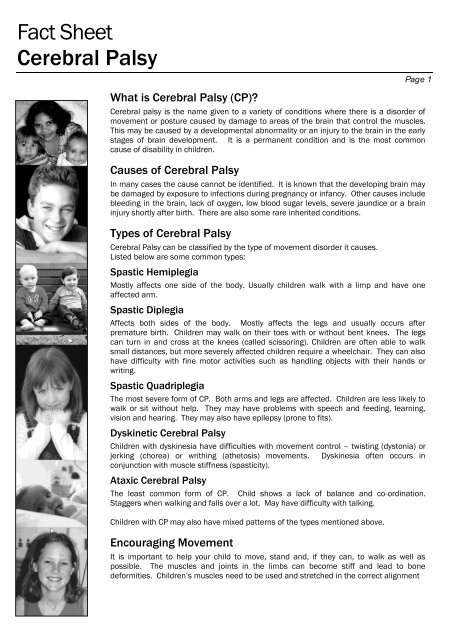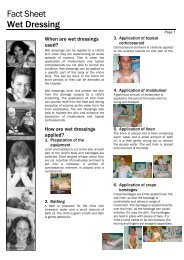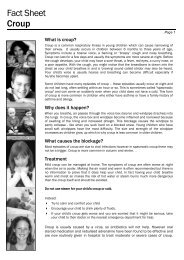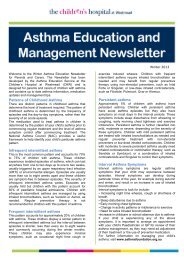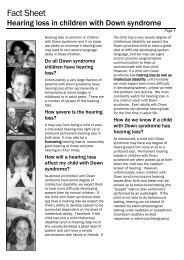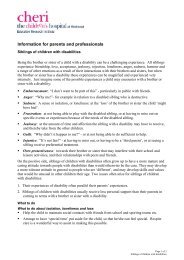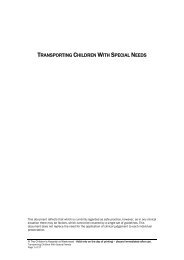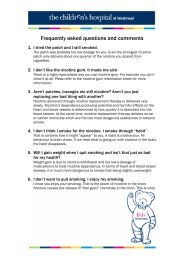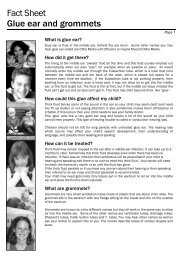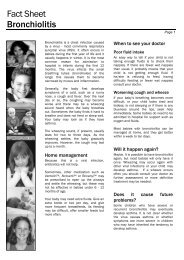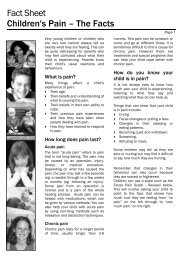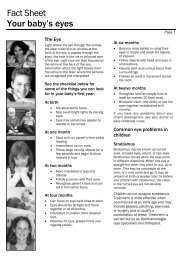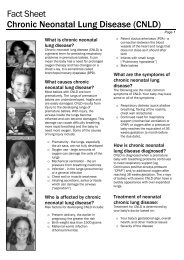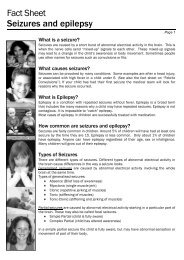Fact Sheet Cerebral Palsy - Kids Health @ CHW
Fact Sheet Cerebral Palsy - Kids Health @ CHW
Fact Sheet Cerebral Palsy - Kids Health @ CHW
You also want an ePaper? Increase the reach of your titles
YUMPU automatically turns print PDFs into web optimized ePapers that Google loves.
<strong>Fact</strong> <strong>Sheet</strong><br />
<strong>Cerebral</strong> <strong>Palsy</strong><br />
xcvxcvxcv<br />
Page 1<br />
What is <strong>Cerebral</strong> <strong>Palsy</strong> (CP)?<br />
<strong>Cerebral</strong> palsy is the name given to a variety of conditions where there is a disorder of<br />
movement or posture caused by damage to areas of the brain that control the muscles.<br />
This may be caused by a developmental abnormality or an injury to the brain in the early<br />
stages of brain development. It is a permanent condition and is the most common<br />
cause of disability in children.<br />
Causes of <strong>Cerebral</strong> <strong>Palsy</strong><br />
In many cases the cause cannot be identified. It is known that the developing brain may<br />
be damaged by exposure to infections during pregnancy or infancy. Other causes include<br />
bleeding in the brain, lack of oxygen, low blood sugar levels, severe jaundice or a brain<br />
injury shortly after birth. There are also some rare inherited conditions.<br />
Types of <strong>Cerebral</strong> <strong>Palsy</strong><br />
<strong>Cerebral</strong> <strong>Palsy</strong> can be classified by the type of movement disorder it causes.<br />
Listed below are some common types:<br />
Spastic Hemiplegia<br />
Mostly affects one side of the body. Usually children walk with a limp and have one<br />
affected arm.<br />
Spastic Diplegia<br />
Affects both sides of the body. Mostly affects the legs and usually occurs after<br />
premature birth. Children may walk on their toes with or without bent knees. The legs<br />
can turn in and cross at the knees (called scissoring). Children are often able to walk<br />
small distances, but more severely affected children require a wheelchair. They can also<br />
have difficulty with fine motor activities such as handling objects with their hands or<br />
writing.<br />
Spastic Quadriplegia<br />
The most severe form of CP. Both arms and legs are affected. Children are less likely to<br />
walk or sit without help. They may have problems with speech and feeding, learning,<br />
vision and hearing. They may also have epilepsy (prone to fits).<br />
Dyskinetic <strong>Cerebral</strong> <strong>Palsy</strong><br />
Children with dyskinesia have difficulties with movement control – twisting (dystonia) or<br />
jerking (chorea) or writhing (athetosis) movements. Dyskinesia often occurs in<br />
conjunction with muscle stiffness (spasticity).<br />
Ataxic <strong>Cerebral</strong> <strong>Palsy</strong><br />
The least common form of CP. Child shows a lack of balance and co-ordination.<br />
Staggers when walking and falls over a lot. May have difficulty with talking.<br />
Children with CP may also have mixed patterns of the types mentioned above.<br />
Encouraging Movement<br />
It is important to help your child to move, stand and, if they can, to walk as well as<br />
possible. The muscles and joints in the limbs can become stiff and lead to bone<br />
deformities. Children’s muscles need to be used and stretched in the correct alignment
<strong>Fact</strong> <strong>Sheet</strong><br />
<strong>Cerebral</strong> <strong>Palsy</strong><br />
xcvxcvxcv<br />
Page 2<br />
in order to grow properly. These shortened muscles and tendons are called contractures<br />
and are one of the most common problems with CP.<br />
Treatments for CP<br />
There is no cure for CP. Active management from an early age will help your child reach<br />
their full potential. The combined efforts of relevant doctors, therapists, counsellors and<br />
educators is required to help your child achieve their goals. As a parent you should be<br />
fully involved in your child’s care, and the decisions made about your child’s treatment.<br />
Physiotherapy and occupational therapy<br />
Involves the use of stretching, strengthening, casting, splints and bracing, positioning and<br />
aiding movement. This is an essential part of the treatment plan of a child with <strong>Cerebral</strong><br />
<strong>Palsy</strong>. Appropriate equipment and, where necessary, changes to the home will also be<br />
advised on by the Physiotherapist and Occupational Therapist.<br />
Medications<br />
Reduction of muscle spasticity and spasms in the early stages of CP can assist in<br />
reducing permanent muscle shortening. Examples of medications are Baclofen (which<br />
may be given orally or by Pump into the fluid around the spinal column), Diazepam and<br />
Botulinum Toxin Injections).<br />
Botulinum Toxin Injections<br />
Botulinum toxin type A (Dysport or Botox ) is a medication used to treat children with<br />
spastic or dystonic <strong>Cerebral</strong> <strong>Palsy</strong>. The botulinum toxin injections work by decreasing the<br />
muscle stiffness (spasticity or dystonia), thus allowing easier movements. Botulinum<br />
toxin is injected directly into the muscles. It does not cure CP. The results from botulinum<br />
toxin treatments are different for each child. Results are related to the severity of the<br />
muscle stiffness, extent of contractures, the age of the child and subsequent therapy.<br />
Improvements are usually seen 2-4 weeks after treatment and can be maintained up to<br />
4-6 months. Repeated injections are usually required.<br />
Surgery<br />
Surgery is sometimes needed when muscle contractures are severe enough to cause<br />
permanent restrictions of movement or bone deformities. There are several types of<br />
surgery used to lengthen muscles, realign bones and treat contractures. The aim of<br />
surgery is to improve movement and function, to allow easier care of the child and in<br />
some cases to prevent painful complications such as dislocated hips.<br />
Remember:<br />
CP is the most common cause of disability in children.<br />
Treatment of CP consists of active management from an early age.<br />
Physiotherapy and occupational therapy is an important part of managing CP.<br />
Some children benefit from speech therapy, medications and surgery.
<strong>Fact</strong> <strong>Sheet</strong><br />
<strong>Cerebral</strong> <strong>Palsy</strong><br />
xcvxcvxcv<br />
This fact sheet is for education purposes only.<br />
Please consult with your doctor or other health professional<br />
to make sure this information is right for your child. This document was reviewed on 19 th October 2011<br />
The next date of review for this document is 19 th<br />
October 2013<br />
www.chw.edu.au www.sch.edu.au www.kaleidoscope.org.au<br />
Page 3<br />
For more information on <strong>Cerebral</strong> <strong>Palsy</strong> here are some website addresses you may find<br />
helpful:<br />
http://www.acd.org.au - Association for Children with a Disability<br />
http://www.acpa-inc.org.au/ - The Australian <strong>Cerebral</strong> <strong>Palsy</strong> Association.<br />
http://www.thespasticcentre.org.au – The Spastic Centre.<br />
References<br />
Dressler, D. (2000) Botulinum Toxin Therapy Georg Thieme Verlag, Stuttgart.<br />
Graham, H.K. (2001) Botulinum Toxin Type A Management of Spasticity in the Context of<br />
Orthopaedic Surgery for Children with Spastic <strong>Cerebral</strong> <strong>Palsy</strong>, European Journal of<br />
Neurology 8(5) 30-39.<br />
Jacobs, J.M. (2001) Management Options for the Child with Spastic <strong>Cerebral</strong> <strong>Palsy</strong><br />
Orthopaedic Nursing 20(3), 53-61.<br />
Aiona, M.D. & Sussman, M.D. (2004) Treatment of Spastic Diplegia in Patients with<br />
<strong>Cerebral</strong> <strong>Palsy</strong> Journal of Pediatric Orthopaedics 13(2), S1-S12.<br />
Aiona, M.D. & Sussman, M.D. (2004) Treatment of Spastic Diplegia in Patients with<br />
<strong>Cerebral</strong> <strong>Palsy</strong>: Part II Journal of Pediatric Orthopaedics 13(3), S13-S38.<br />
Becher, J.G. (2002) Pediatric Rehabilitation in Children with <strong>Cerebral</strong> <strong>Palsy</strong>: General<br />
Management, Classification of Motor Disorders Journal of Prosthetics and Orthotics<br />
14(4), 144-149.<br />
© The Children’s Hospital at Westmead, Sydney Children’s Hospital, Randwick & Kaleidoscope * Hunter Children’s <strong>Health</strong> Network – 2005-2011


